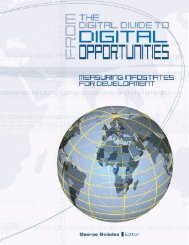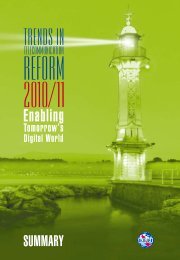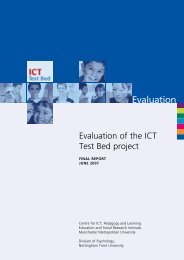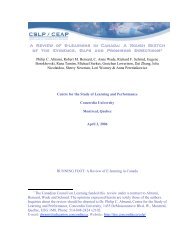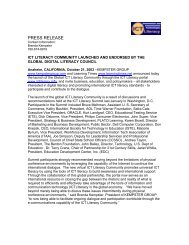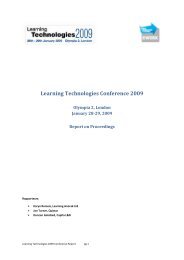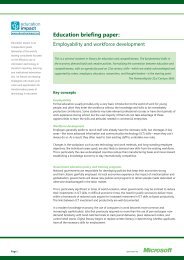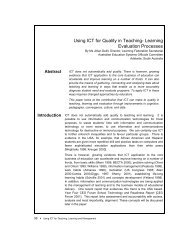147 pages pdf - ICT Digital Literacy
147 pages pdf - ICT Digital Literacy
147 pages pdf - ICT Digital Literacy
You also want an ePaper? Increase the reach of your titles
YUMPU automatically turns print PDFs into web optimized ePapers that Google loves.
Pedagogy & Webagogy -- Ready, Set … TRAIN and FACILITATE!<br />
#539: Embed The Online "Stuff"<br />
Relate other parts of the course to the online discussion. For example: post instructions for<br />
assignments; attach documents and graphics to postings, discuss results of Web research<br />
related to assignments, plan and communicate for group projects, etc.<br />
Kate MacDonald<br />
Massachusetts College of Pharmacy & Health Sciences<br />
#540: To Make e-Learning More Effective, Take AIM!<br />
A - assess your teaching style<br />
I - investigate instructional strategies within that style<br />
M - match appropriate instructional technologies and, in particular, e-Learning tools to the<br />
strategies and style with which you are most comfortable<br />
Susan Stansberry, Ed.D.<br />
Oklahoma State Univ. College of Education<br />
#541: Build Community & Participation - For Free!<br />
In teaching graduate students, we have begun to experiment with the use of free discussion boards (e.g.<br />
QuickTopic) as well as the use of free VoIP Instant Messenger to extend the classroom throughout the<br />
week. The reason that we are using these free services is that we want to model to our students, who are<br />
K-12 teachers, what they may be able to do with their own students. Many of our student's school districts<br />
do not have the funds for commercial tools and products and "freeware" is the only way to go for them. Our<br />
experience has been that the use of this additional tool to the teacher's and student's tool kit is fantastic.<br />
Properly utilized, asynchronous discussion boards greatly extend the dialogue, reflection, and interaction<br />
among students. Over a period of time, with occasional intervention by the professor, one can see the<br />
development of a wonderful learning community in the reflection and reaction of participants.<br />
Bill Kiley<br />
Kiley and Associates<br />
#542: Reality Check<br />
Everyone knows the importance of simulations. Unfortunately, few of us have the resources to<br />
build them effectively. So don't be afraid to blend your online learning with experiential learning<br />
in the real application or, if that puts real data at risk, with a controlled training database.<br />
Connie Koskinen<br />
Federated System Group<br />
#543: Getting Our Students "There"<br />
In a virtual classroom it is even more important to focus on establishing a rapport at the start with the virtual<br />
students you can't see. Many times you have the advantage of sound and the ability to conference in but no<br />
visual feedback from the students. You must concentrate on listening even more and try to pick up tones of<br />
voice or changes in volume as your cue. Establishing this up-front puts students in a positive state of mind.<br />
Howard Goldstein<br />
Howard Goldstein Associates<br />
#544: Be Flexible & Don't Keep Users In The Dark<br />
Define what you expect from users and be flexible when you can. First example: voice connection. Don't think<br />
all or nothing. Everyone won't have a great connection, so Voice Over IP won't work for all. Have a phone link<br />
and let the user decide whether to do Voice Over IP or use a land line or cell phone. Second example: Internet<br />
connection: Can they attend in groups or are you doing interactive polling or tests that require each individual to<br />
have a connection? Users need to know ahead of time.<br />
Patty Crowell<br />
LSI Logic Storage Systems<br />
701 e-Learning Tips by The MASIE Center www.masie.com 108





